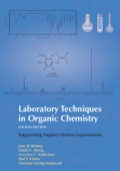
Interpretation:
The superheating of liquid should be explained.
Concept introduction:
Many organic reactions are not spontaneous and require heat for the initiation of the
The liquid and solid reagents are heated by various processes but with specific laboratory equipment. Heating and cooling are used in various processes like recrystallization and distillation.
Explanation of Solution
Superheating is the phenomenon when the liquid is heated above its boiling point but does not boil because the formation of bubbles is kinetically prevented. It is a phenomenon caused by the temperature gradient in the liquid that lowers the temperature at the surface and lowers the temperature at the bottom of the liquid near the heat source.
It is mainly carried out in the vessels with a smooth surface that does not offer much opportunity for the formation of the bubbles. The superheating process can lead to loss of the product and potentially dangerous situation if it is splattered out of the container and causes burns.
Want to see more full solutions like this?
Chapter 6 Solutions
EBK LABORATORY TECHNIQUES IN ORGANIC CH
- Give an example of metal which(i) is a liquid at room temperature(ii) can be easily cut with knife(iii) is best conductor of heat(iv) is poor conductor of heatarrow_forwardWhat is the property of a material that makes it transparent? Why does mineral such as emerald show coloration?arrow_forwardLubricants are substances with high ____________ that reduce friction between working parts.arrow_forward
- Synthetic fibers possess the physical property of___________ because they are crystalline.arrow_forwardWhat is supercritical fluid?arrow_forwardWhat happens to a snowflake when it is put in the freezer? does it melt or does it become glass ice?without any additional compounds, only snowflake in the freezer what would happen?arrow_forward
- What is the liquid density of Propane as a fuel?arrow_forwardWhy small grain size metals have the temperature environment greater mechanical strength than if they had larger grains?arrow_forwardDr Kootsookos was cooking breakfast one day and the saucepan handle got hot and crumbled in her hand. The saucepan handle was probably: a.) made of a thermoplastic b.) made of a thermoset c.) made of an elastomer d.) made of a ceramicarrow_forward
- Chemistry: Matter and ChangeChemistryISBN:9780078746376Author:Dinah Zike, Laurel Dingrando, Nicholas Hainen, Cheryl WistromPublisher:Glencoe/McGraw-Hill School Pub Co
 Chemistry for Engineering StudentsChemistryISBN:9781285199023Author:Lawrence S. Brown, Tom HolmePublisher:Cengage Learning
Chemistry for Engineering StudentsChemistryISBN:9781285199023Author:Lawrence S. Brown, Tom HolmePublisher:Cengage Learning Chemistry for Today: General, Organic, and Bioche...ChemistryISBN:9781305960060Author:Spencer L. Seager, Michael R. Slabaugh, Maren S. HansenPublisher:Cengage Learning
Chemistry for Today: General, Organic, and Bioche...ChemistryISBN:9781305960060Author:Spencer L. Seager, Michael R. Slabaugh, Maren S. HansenPublisher:Cengage Learning  World of Chemistry, 3rd editionChemistryISBN:9781133109655Author:Steven S. Zumdahl, Susan L. Zumdahl, Donald J. DeCostePublisher:Brooks / Cole / Cengage Learning
World of Chemistry, 3rd editionChemistryISBN:9781133109655Author:Steven S. Zumdahl, Susan L. Zumdahl, Donald J. DeCostePublisher:Brooks / Cole / Cengage Learning Introductory Chemistry: A FoundationChemistryISBN:9781337399425Author:Steven S. Zumdahl, Donald J. DeCostePublisher:Cengage Learning
Introductory Chemistry: A FoundationChemistryISBN:9781337399425Author:Steven S. Zumdahl, Donald J. DeCostePublisher:Cengage Learning





